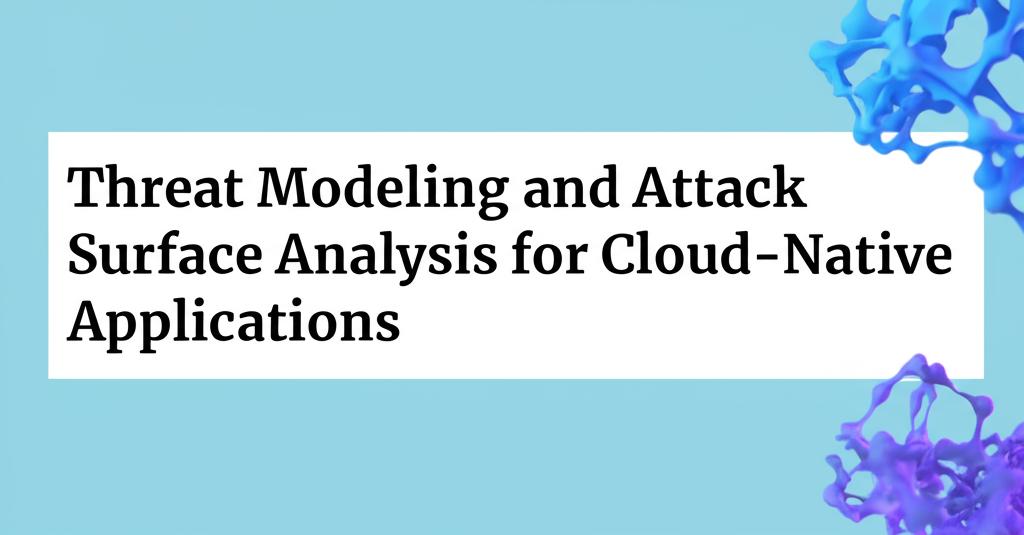Cloud-native architectures, utilizing microservices, containers, serverless functions, and dynamic orchestration, offer incredible agility and scalability. However, this dynamism also creates complex and evolving security challenges. Understanding and mitigating potential threats requires a proactive approach, specifically through robust Threat Modeling and continuous Attack Surface Analysis tailored for these environments.
Understanding the Cloud-Native LandscapeUnlike monolithic applications, cloud-native systems are distributed and constantly changing. Key characteristics influencing security include:
- Ephemeral Infrastructure: Compute instances, containers, and functions can be short-lived, making traditional perimeter security less effective.
- Extensive API Use: Microservices communicate heavily via APIs, significantly expanding the potential entry points for attackers.
- Shared Responsibility: Cloud providers manage the underlying infrastructure security, but application-level security, configuration, and data protection remain the customer's responsibility.
- Infrastructure as Code (IaC): While enabling automation, misconfigurations in IaC templates can lead to widespread vulnerabilities.
- Complex Dependencies: Applications often rely on numerous managed cloud services, open-source libraries, and third-party integrations, each introducing potential risks.
- CI/CD Pipelines: These automation pipelines are critical infrastructure and can be targets themselves, potentially injecting malicious code or compromising deployment processes.
Threat modeling is a structured process to identify potential threats, vulnerabilities, and missing safeguards early in the development lifecycle. While traditional methodologies like STRIDE (Spoofing, Tampering, Repudiation, Information Disclosure, Denial of Service, Elevation of Privilege) are still relevant, they must be adapted:
- Focus on Data Flows and Trust Boundaries: Map how data moves between microservices, APIs, managed services, and external users. Identify where trust levels change (e.g., between an external API gateway and internal services).
- Model Key Components: Analyze individual microservices, serverless functions, container configurations, orchestration manifests (like Kubernetes YAML), CI/CD pipeline stages, and managed cloud services (databases, queues, storage).
- Incorporate the Cloud Environment: Consider threats specific to the cloud provider (e.g., compromised IAM roles, misconfigured security groups, leaky storage buckets) and the shared responsibility model.
- Automate Where Possible: Leverage tools that can analyze IaC templates or generate data flow diagrams to assist in the modeling process, especially in rapidly changing environments.
- Make it Continuous: Threat modeling shouldn't be a one-off activity. Revisit models whenever significant architectural changes occur, new services are integrated, or new threat intelligence emerges. Integrate it into the design phase and update it throughout the lifecycle.
Attack Surface Analysis complements threat modeling by focusing specifically on identifying all possible points where an attacker could attempt to interact with or compromise the application. In a cloud-native context, this surface is broad and dynamic:
- APIs: External and internal APIs are primary targets. Analyze authentication, authorization, rate limiting, and input validation.
- Network Exposure: Identify open ports, misconfigured security groups or network ACLs, public-facing load balancers, and direct internet access to container nodes or serverless functions.
- Container Images and Registries: Scan images for vulnerabilities in base layers and dependencies. Secure access to container registries.
- Orchestration Platforms (e.g., Kubernetes): Assess RBAC configurations, network policies, secrets management, and the security of the control plane itself.
- Serverless Functions: Analyze function triggers (HTTP endpoints, queue events), permissions (IAM roles), and dependencies.
- Cloud Service Configurations: Regularly audit configurations of databases, storage buckets, messaging queues, and identity management services for insecure defaults or misconfigurations.
- CI/CD Pipeline Components: Secure source code repositories, build servers, artifact repositories, and deployment tools.
- Third-Party Dependencies: Include SaaS integrations, open-source libraries, and managed services in the analysis. Use Software Composition Analysis (SCA) tools.
- User Interfaces: Web frontends and mobile applications remain part of the attack surface.
The key to securing cloud-native applications is embedding threat modeling and attack surface analysis into the development and operations workflow ("Shift Left"):
- Design Phase: Conduct initial threat modeling sessions.
- Development Phase: Utilize SAST and SCA tools to find vulnerabilities in code and dependencies.
- CI/CD Pipeline: Integrate automated security checks, including DAST, container scanning, and IaC analysis. Continuously monitor the attack surface.
- Deployment: Enforce secure configurations and policies using tools like Kubernetes Admission Controllers or cloud policy engines.
- Operations: Implement continuous monitoring, logging, alerting, and regular security audits (CSPM/KSPM). Update threat models and re-evaluate the attack surface based on operational data and emerging threats.
By adopting continuous threat modeling and dynamic attack surface analysis tailored to the specifics of cloud-native environments, organizations can proactively identify and mitigate risks, building more resilient and secure applications in the cloud.

